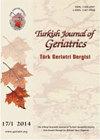冠心病重症监护病房老年急性失代偿性心力衰竭患者不同营养评分的关系
IF 0.3
4区 医学
Q4 GERIATRICS & GERONTOLOGY
Turkish Journal of Geriatrics-Turk Geriatri Dergisi
Pub Date : 2023-06-01
DOI:10.29400/tjgeri.2023.343
引用次数: 0
摘要
心衰和营养不良之间的关系是显著的。最常用的营养指标是预后营养指数、控制营养状况和白蛋白-胆红素分级。我们旨在探讨老年急性失代偿性心衰患者营养状况的临床影响,以及预后营养指数、控制营养状况和白蛋白胆红素等级营养指数之间的关系,以检测12个月和3个月的再住院率、死亡率和在冠状动脉重症监护病房的住院时间。我们的研究首次评估了土耳其研究队列的控制营养状况和白蛋白-胆红素等级。材料与方法:回顾性分析冠心病重症监护病房1162例患者的病历资料。共纳入123例患者。结果:我们发现预后营养指数、白蛋白-胆红素等级和控制营养状态评分与死亡率之间存在统计学差异。然而,最具统计学意义的关系是在预后营养指数评分中发现的。我们发现,随着营养评分的恶化,住院时间延长。短期白蛋白胆红素分级评分和长期控制营养状况评分显示再住院无统计学意义。结论:预后营养指数是老年急性失代偿性心衰患者死亡率、短期和长期再住院率以及住院时间的独立预测因子。其预测能力优于本研究评估的白蛋白-胆红素分级和控制营养状况评分。关键词:心力衰竭;营养不良;岁的;冠状动脉护理科;营养状况。本文章由计算机程序翻译,如有差异,请以英文原文为准。
Relationship Between Different Nutritional Scores in Elderly Patients with Acute Decompensated Heart Failure in the Coronary Intensive Care Unit
Introduction: The relationship between heart failure and malnutrition is significant. The most commonly used nutritional indices are theprognostic nutritional index, controlling nutritional status, and albumin–bilirubin grade. We aimed to investigate the clinical impact of nutritional status in elderly acute decompensated heart failure patients and the relationship between the prognostic nutritional index, controlling nutritional status, and albumin–bilirubin grade nutritional indices to detect 12-month and 3-month rehospitalization rates, mortality, and length of stay in the Coronary Intensive Care Unit. Our study is the first to evaluate the controlling nutritional status and albumin–bilirubin grade in our study cohort in Turkey. Materials and Methods: The medical records of 1162 patients hospitalized in the Coronary Intensive Care Unit were evaluated retrospectively. A total of 123 patients were included. Results: We found a statistically significant difference between the prognostic nutritional index, albumin–bilirubin grade and controlling nutritional status scores and mortality. However, the most statistically significant relationship was found in the prognostic nutritional index score. We found that as the nutritional scores worsened, the length of hospital stay was prolonged. The albumin–bilirubin grade score in the short term and controlling nutritional status score in the long term were not statistically significant to show rehospitalization. Conclusion: Prognostic nutritional index is an independent predictor of mortality, short- and long-term rehospitalizations, and length of stay in elderly patients with acute decompensated heartfailure. Its predictive power was better than the albumin–bilirubin grade and controlling nutritional status scores evaluated in our study. Keywords: Heart Failure; Malnutrition; Aged; Coronary Care Unit; Nutritional Status.
求助全文
通过发布文献求助,成功后即可免费获取论文全文。
去求助
来源期刊

Turkish Journal of Geriatrics-Turk Geriatri Dergisi
GERIATRICS & GERONTOLOGY-
CiteScore
0.60
自引率
0.00%
发文量
46
审稿时长
6-12 weeks
期刊介绍:
Turkish Journal of Geriatrics is a peer-reviewed journal. Official language of the journal is English. Turkish Journal of Geriatrics invites submission of Original Articles based on clinical and laboratory studies. Review Articles are published only after the invitation from the Editorial Board.
 求助内容:
求助内容: 应助结果提醒方式:
应助结果提醒方式:


